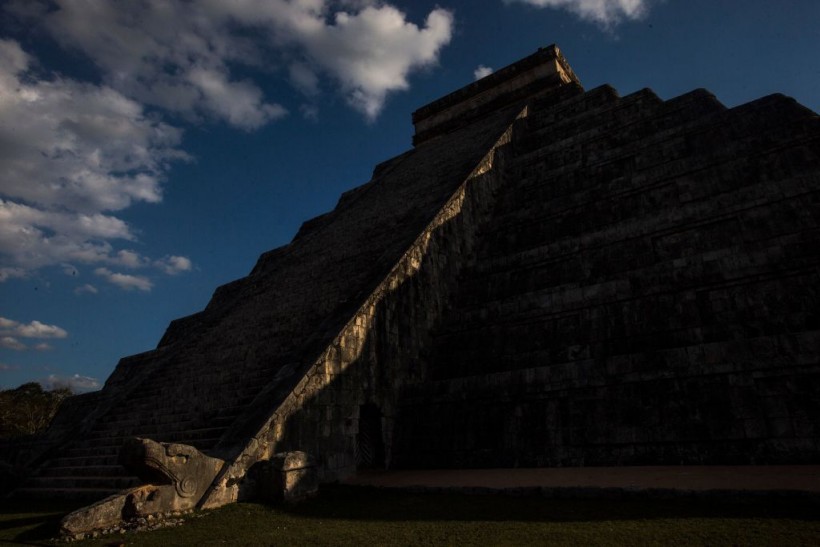A construction site near the city of Merida, Mexico, was discovered with unexpected clues to the Maya civilization's history back in 2015. According to a new study, the archaeological place was previously one of the ancient cities full of social and economic activities.
The once-bustling Maya metropolis had approximately 4,000 residents, the research suggests. The city was constructed in the Yucatan Peninsula during the pre-Hispanic period. According to the scientists, this region was first developed by the ancient Mexican settlers between 600 AD to 900 AD, identifying the age of the place between 1,100 to 1,400 years old.
Xiol Metropolis in Yucatan Peninsula Excavated

View the stairs of the castle of Kukulcan at the Mayan archaeological site of Chichen Itza in Yucatan State, Mexico, during the celebration of the spring equinox on March 21, 2022.
Evidence regarding the name of the Mayan metropolis is insufficient, leading archaeologists to dub the city 'Xiol,' which translates in the Mayan language as the 'spirit of man.'
The heritage of Xiol is suspected of having served as a large place for a variety of flourishing cultures during its time. According to the experts that analyzed the metropolis, Xiol was once filled with pyramids, royal palaces, public plazas, and even a natural sinkhole (cenote).
The city was also likely home to people of various social classes, including priests, dignitaries, scribes, farmers, and even fishers.
Despite the majority of the place being destroyed due to the expansion of a nearby municipality of Kanasin, preserved archaeological structures and artifacts remained in the forgotten city.
Yucatan Magazine reports that Xiol will be opened for public exhibits soon this year.
Mexico National Institute of Anthropology specialist and lead of the Xiol research Carlos Peraza Lope explained in a Reuters interview that even their archaeological team was surprised by the unexpected discoveries on the site, especially since it was preserved so well through time.
Archaeologists have revealed the remains of Xiol, a 1,500-year-old Mayan city in Mexico's Yucatan, home of some 4,000 people between 600 and 900 CE. Its Puuc style architecture, like Chichen Itza pyramid, is more typically found in Yucatan's southern parthttps://t.co/wv3HY5fdLF pic.twitter.com/vc4o6cJvcY
— Alfons López Tena 🦇 (@alfonslopeztena) May 28, 2022
The old Yucatan city included buildings that followed one of the prevalent styles in the Maya culture, called Puuc architecture. This approach includes decorative designs for many structures and could also be observed from the buildings from a separate site known as Chichen Itza.
Xiol's Puuc style is unique, as the design was first thought exclusive to southern parts of Yucatan state and absent in parts near Merida, Milenio reports.
The Disappearance of Xiol and the Maya Civilization
The first people of Yucatan arrived in 2,500 BC. Since then, the groups have constructed different monuments in the ancient state. These infrastructures were commonly dedicated to traditional ceremonies and economic trades.
The Maya civilization gained a population of over 19 million individuals during its peak. While they are building history, other groups of Mesoamericans were also on the verge of expansion in southern lowlands, including Belize, Mexico, Honduras, and Guatemala, Smithsonian Magazine explains.
In 900 AD, all Yucatan populations abandoned the cities due to unknown factors. Experts theorize that the disappearance of the people, as well as the collapse of the northern lowland regions, were due to uncontrollable droughts, shifts in trade patterns, and warfare.
The discovery in Xiol included 12 buildings, a special altar, and a central plaza across 51-acre land. Burial sites found in the place had 15 remains of children and adults alongside artifacts such as personal pieces of jewelry and other ceramics utilized in their daily life, EFE reports.
RELATED ARTICLE: Saqqara Necropolis Discovered with Late Egyptian Period Artifacts; Collection Included Cat Mummies, Sarcophagi, and Figures of Ancient Gods
Check out more news and information on Archaeology in Science Times.











!['Cosmic Glitch' in Einstein's Theory of General Relativity Could Be Explained in This New Scientific Tweak [Study]](https://1721181113.rsc.cdn77.org/data/thumbs/full/53435/258/146/50/40/cosmic-glitch-in-einsteins-theory-of-general-relativity-could-be-explained-in-this-new-scientific-tweak-study.jpeg)


